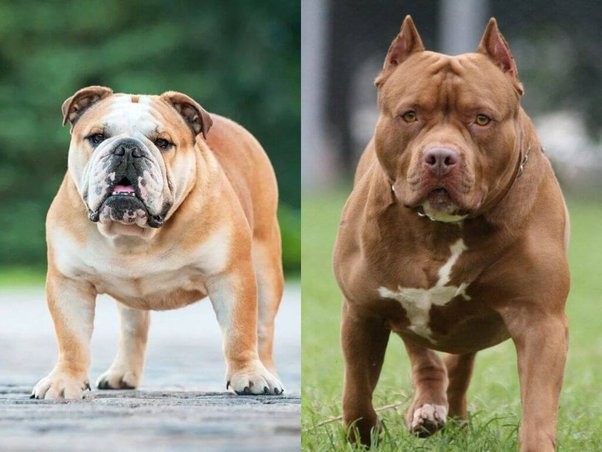
The ongoing debate between Pit Bulls and Bulldogs has created significant confusion among potential dog owners and enthusiasts. While these breeds share common ancestry through the English Bulldog, they exhibit distinct characteristics in terms of size, temperament, and breed classification. Notably, "Pit Bull" serves as an umbrella term encompassing several breeds like the American Pit Bull Terrier and American Staffordshire Terrier, while Bulldogs represent specific breeds such as the English and American Bulldog. This report examines the fundamental differences and similarities between these breeds to provide clarity for potential owners and breed enthusiasts.
Physical Characteristics and Behavioral Traits
Facial Structure Comparison
While both breeds have muscular builds, their facial features differ significantly. American Bulldogs have a more squished face with prominent wrinkles around the eyes, nose, and forehead. Their heads are blocky with the lower jaw protruding slightly beyond the upper jaw. In contrast, Pit Bulls have a more athletic-looking face with longer snouts, fewer wrinkles, and more rounded, wedge-shaped heads.
Intelligence and Problem-Solving Abilities
The breeds exhibit distinct cognitive traits. American Bulldogs demonstrate strong problem-solving capabilities and environmental adaptability, though they may take longer to learn new commands. Pit Bulls show average to above-average intelligence with quick command learning but excel specifically at problem-solving tasks. This is evidenced by their ability to figure out mechanisms like clip-open style locks. While American Bulldogs are considered "one-trick ponies" in terms of learning abilities, they still rank higher in intelligence compared to other large breeds. Pit Bulls' intelligence manifests more in practical problem-solving rather than trick performance.
Introduction to Pit Bulls vs Bulldogs: Understanding the Breeds
Breed Classification and Origins
While commonly confused, the key distinction lies in classification - Pit Bull is not a specific breed but rather an umbrella term encompassing several breeds including American Pit Bull Terrier, American Staffordshire Terrier, and Staffordshire Bull Terrier. The American Bulldog, however, is a distinct purebred dog breed developed from English Bulldogs brought by colonists in the 17th century. Originally used for farm work and cattle herding, American Bulldogs were saved from near extinction after WWII through careful breeding programs.
Breed Recognition and Legal Status
The breeds face different levels of official recognition and legal restrictions. The American Bulldog gained recognition from the American Kennel Club in 2019 through their Foundation Stock Service program. In contrast, Pit Bulls face breed-specific legislation and bans in several countries including Australia, France, Belgium, and Germany. This disparity stems largely from historical breeding purposes - while American Bulldogs were bred for farm work, Pit Bulls originated from breeding programs focused on blood sports like bull-baiting between the 16th and 19th centuries, leading to ongoing stigma despite evidence challenging aggressive temperament assumptions.
Key Differences Between Pit Bulls and Bulldogs: Physical Traits, Temperament and Health
Size and Build Comparison
While previous sections covered facial features, distinct differences exist in overall build. American Bulldogs are notably larger, with males weighing 60-110 pounds and standing 20-27 inches tall, comparable to a basketball in head size. Pit Bulls are more compact and athletic, weighing 35-60 pounds and reaching 18-21 inches in height, with a head size similar to a carry-on suitcase. This size difference impacts their lifespan, with larger American Bulldogs typically living 10-12 years compared to Pit Bulls' 12-14 years.
Health Concerns and Social Characteristics
The breeds face different health challenges and social tendencies. American Bulldogs commonly develop hip dysplasia and skin problems, particularly in their facial folds. Pit Bulls more frequently experience patella luxation, affecting their mobility. Regarding temperament with food, American Bulldogs show notable food guarding behaviors, while Pit Bulls typically don't display this trait. In social settings, American Bulldogs generally demonstrate higher tolerance toward other animals, making them more suitable for multi-pet households. However, Pit Bulls require more careful introduction to other pets due to their higher prey drive, though both breeds benefit significantly from early socialization and training.
Training and Cost Considerations
Training Requirements and Challenges
While previous sections discussed intelligence and behavioral traits, the training approaches differ significantly. American Bulldogs require leadership-focused training sessions, craving structure but exhibiting stubbornness that demands patience. Pit Bulls, despite their strength, demonstrate higher eagerness to please during training, making them more responsive to obedience commands. Both breeds need early socialization, but American Bulldogs particularly benefit from structured training environments that establish clear boundaries.
Adoption Costs and Availability
The financial investment varies considerably between breeds. Pit Bulls are more readily available and affordable, with 15-20% of shelter dogs being Pit Bulls and adoption fees ranging from $150-500. American Bulldogs are scarcer in shelters, typically requiring purchase from breeders at costs between $1,000-1,500. This price difference reflects both availability and breeding program costs, with American Bulldogs having more controlled breeding practices due to their purebred status. The higher investment in American Bulldogs often includes more comprehensive health screening and documentation of lineage.
Conclusion
The comparison between Pit Bulls and American Bulldogs reveals distinct differences across multiple characteristics. While Pit Bulls are not a specific breed but rather a group of related breeds, American Bulldogs are a distinct purebred with official AKC recognition. Key physical differences include size (American Bulldogs being notably larger), facial structure (Bulldogs having more wrinkled, squished faces), and build (Pit Bulls being more athletic and compact). In terms of temperament and training, Pit Bulls demonstrate higher eagerness to please and quick command learning, while American Bulldogs require more structured, leadership-focused training despite their strong problem-solving abilities.
These differences have practical implications for potential owners. American Bulldogs typically require a higher initial investment ($1,000-1,500) and face specific health challenges like hip dysplasia and skin problems, but show better tolerance toward other pets. Pit Bulls are more affordable and readily available in shelters ($150-500) but face breed-specific legislation in several countries and require careful introduction to other pets due to their higher prey drive. Understanding these distinctions is crucial for prospective owners to make informed decisions based on their lifestyle, living situation, and capacity for training and care.